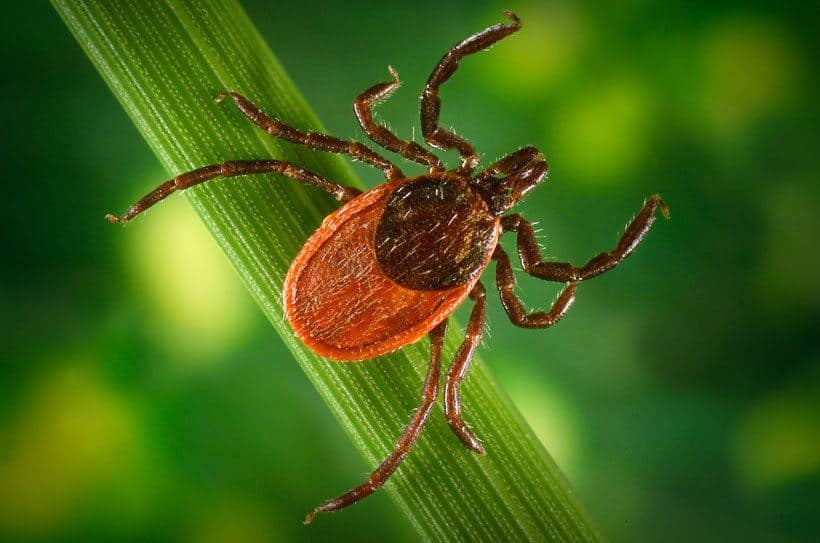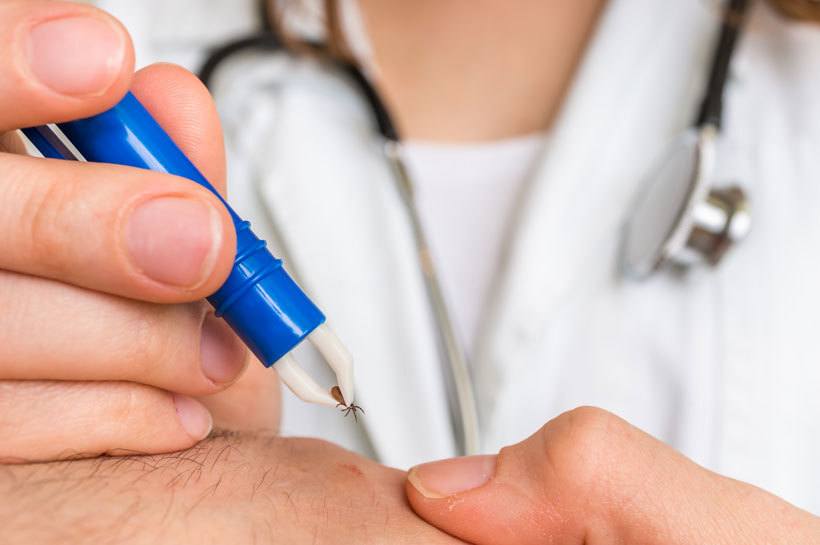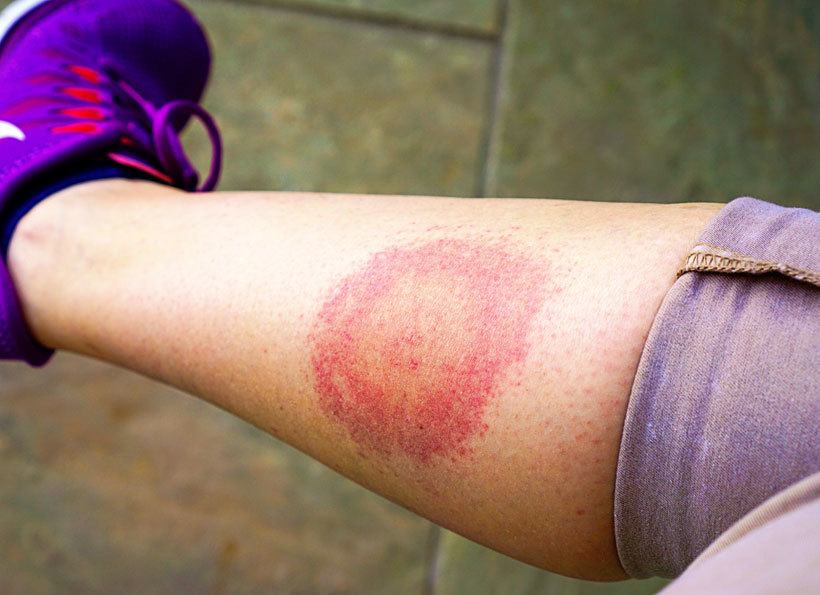Summer time is here, and with it tiny critters that may look small, but have a powerful bite. My family has experienced Lyme disease in children first hand. Living in Maryland, you can’t avoid ticks even if you try. Deer wander through our backyard, despite the fact that we live in an urban suburb just outside of Washington, D.C. They bring ticks with them. Lucky us.

Our Experience with Lyme Disease in Children
We aren’t sure exactly where my son picked up a tick, because we never even saw one on him. Our family had gone up to the lake in New Hampshire that we visit every summer. The kids play in the woods. Who knows how many deer have passed through, although I’ve never seen any. Then again, we live in Maryland. Maybe he got bit there.
The Lyme Disease Rash
One day after my son was swimming and took off his UV shirt I discovered large red circles on his torso, back and legs. At first, we thought it might be ringworm. Who knows how much lake water he had been drinking and what was in there. We began to use an anti fungal spray to combat the rash. We had no reason to think it was lyme. After all, everyone knows that the lyme disease rash has a bullseye in the center. That’s what all of the lyme disease rash pictures show at least, right?
Oh, how little we knew then.
Scroll down for lyme disease symptoms and treatments

Our Lyme Disease Misdiagnosis
When we got back home a few days later both boys had swimmers ear, so I figured we might as well get the rash rings looked at too. Our pediatrician listened to me tell her that we had been at the lake and I just assumed it was ringworm.
Even though we live in one of the highest concentrations of ticks in the country, she took my diagnosis and assumed I was right without even testing my child for lyme disease. I thought all was good. Four days later more spots had started to show up. This was obviously not getting better with an anti fungal.
Back to the doctor we went.

Final Lyme Disease Diagnosis
Our regular pediatrician wasn’t working in the office that morning, so her colleague saw us. My son already had his shirt off when she walked into the exam room. She took one look at him and said “yup. That’s lyme disease.” She had another doctor give a second opinion, and my son was immediately put on antibiotics. She administered a lyme disease test just in case, but we weren’t taking any chances. Lyme disease treatment was started immediately.
Needless to say, we no longer go to our regular pediatrician. As the doctor, it was her job to rule out the possibility of lyme disease in my children given the fact that we live in Maryland. What the heck do I know?! I didn’t get a medical degree.
My husband also had lyme disease we soon found out. Two of my men, one of whom (my husband) wasn’t even in New Hampshire, were obviously hit with tick bites in our Maryland neighborhood.
Lyme Disease Treatment
Two weeks and one very chalky antibiotic that required a cookie after every dose to get the taste out of my son’s mouth, and the rash was gone. My son’s lyme disease was caught in time thank goodness, as was my husband, but not everyone is so lucky. Many people have lasting effects from lyme disease in children and adults that isn’t caught early or goes untreated. The key is early detection and knowing what a lyme disease rash can look like. It is not always what you think.
The Facts about Lyme Disease in Children

What causes lyme disease
- Blacklegged ticks
- According to the CDC, “Many types of ticks bite people in the U.S., but only blacklegged ticks transmit the bacteria that cause Lyme disease. Furthermore, only blacklegged ticks in the highly endemic areas of the northeastern and north central U.S. are commonly infected. Finally, blacklegged ticks need to be attached for at least 24 hours before they can transmit Lyme disease.”
Where does lyme disease most often occur?
The easy answer is the northeast and upper Midwest sections of the United States. About 14 states regular report cases, including:
- Connecticut
- Delaware
- Maine
- Maryland
- Massachusetts
- Minnesota
- New Hampshire
- New Jersey
- New York
- Pennsylvania
- Rhode Island
- Vermont
- Virginia
- Wisconsin
How to prevent Lyme Disease in Children
- Bug Spray. If you live in a high tick areas or are hiking in the woods, wear bug spray.
- Treat your clothing. Use an odorless (after drying) permethrin spray to treat all of your clothing. It can last up to six washes and won’t stain your clothing. Just don’t use it on your skin.
- Body Check. Ticks love warm places. When you get inside or return to your car after a hike, check behind your ears, in sock lines, hair lines, and all appendages.
- Long clothing. Where pants and long sleeves whenever possible.
- Walk in the center of trails. There is nowhere to hide on a trail.
- Avoid tall grass and wooded areas. Ticks love to hide in here.

How to Remove a Tick
Ticks have 24 hours to sink in their evil magic. According to the CDC, to remove a tick you simply take a pair of fine-tipped tweezers, like these, grasp the tick as close to the surface of the skin as possible and pull upward. Flush the tick down the toilet as soon as possible. Do NOT crush it with your fingers. Wash the skin area with rubbing alcohol, iodine scrub or soap and water. Monitor your child’s health for a rash or fever over the next few weeks.
Lyme disease symptoms
Early Lyme symptoms can occur anywhere from three to 30 days after a tick bite. A rash only occurs in about 70-80 percent of infected patients. A bullseye is not the only sign of lyme disease you should look out for in children. Here are the most common symptoms:
- Bulls eye lyme rash. This is the most common sign of lyme disease.
- Red blotches. You don’t need a bullseye in the center of a red ring to have lyme disease. If you see a suspicious rash, call your doctor.
- Rashes generally do not itch and can appear anywhere on the body.
- If a fever appears during the summer months, check for a rash.
- Swollen Knees
- Facial Palsy (side of the face loses muscle power)
For more information, check the CDC website.

Lyme Disease Testing
- Most often a rash, exposure to a tick and/or physical symptoms are enough to diagnose a child with Lyme disease.
- In some cases, a Lyme blood test will be needed to check if your child has lyme disease or not
- Note: Blood tests aren’t fun for kids (or adults) of any age. Bring a treat and be prepared to give a lot of hugs and hold your child while their blood is drawn. Tears will fall. It will be OK.
Treating Lyme Disease in Children
Lyme disease in children and adults is treated with antibiotics. Period. This is the only known way to fight the disease, according to the CDC.
- Oxycycline
- Amoxicillin
- Cefuroxime axetil
If Lyme goes untreated it can lead to nerve damage, irregular heart beat, short-term memory problems, and arthritis.
Lyme disease rash and removing a tick via ShutterStock.com. Feature image courtesy of the CDC.


Some misinformation here,but perhaps at the time of writing this was as current as you knew. Never throw the tick away, always keep it for sending to CDC to be analyzed and or send to researchers. Often there is a false negative in bloodwork, and also no rash, our child was bit on the skull, it went very red and scanned over, but no rash t9 identify, so you must be aware of all other symptoms. Wish it was simple as your experience has been but many families have to fight to get testing and medical attention and risk being labelled as crazy
Thank you so much for your insight. I’m so sorry your son also suffered from a tick attack. Like you said, every experience is different and symptoms do vary (my husband also had lyme that same summer and his symptoms were drastically different from our son’s. My BIL is also suffering from longterm effects of Lyme disease). Our experience certainly wasn’t simple and we had to fight to get my son tested. Needless to say, every parent, especially if you live in a high risk area, should fight for the lyme test. And if your doctor doesn’t listen, find a new doctor like we did in the end who takes these things seriously.